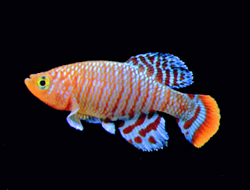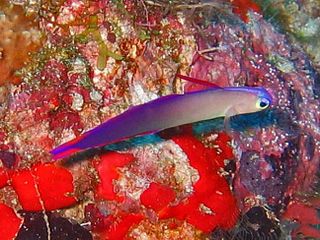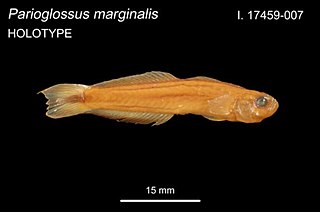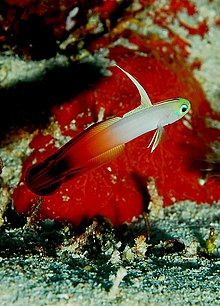
Catfish are a diverse group of ray-finned fish. Named for their prominent barbels, which resemble a cat's whiskers, catfish range in size and behavior from the three largest species alive, the Mekong giant catfish from Southeast Asia, the wels catfish of Eurasia, and the piraíba of South America, to detritivores, and even to a tiny parasitic species commonly called the candiru, Vandellia cirrhosa. Neither the armour-plated types nor the naked types have scales. Despite their name, not all catfish have prominent barbels or "whiskers". Members of the Siluriformes order are defined by features of the skull and swimbladder. Catfish are of considerable commercial importance; many of the larger species are farmed or fished for food. Many of the smaller species, particularly the genus Corydoras, are important in the aquarium hobby. Many catfish are nocturnal, but others are crepuscular or diurnal.

Clupeiformes is the order of ray-finned fish that includes the herring family, Clupeidae, and the anchovy family, Engraulidae. The group includes many of the most important forage and food fish.

Characiformes is an order of ray-finned fish, comprising the characins and their allies. Grouped in 18 recognized families, more than 2000 different species are described, including the well-known piranha and tetras.

Characidae, the characids or characins is a family of freshwater subtropical and tropical fish, belonging to the order Characiformes. The name "characins" is the historical one, but scientists today tend to prefer "characids" to reflect their status as a by and large monophyletic group at family rank. To arrive there, this family has undergone much systematic and taxonomic change. Among those fishes that remain in the Characidae for the time being are the tetras, comprising the very similar genera Hemigrammus and Hyphessobrycon, as well as a few related forms such as the cave and neon tetras. Fish of this family are important as food and also include popular aquarium fish species.

Gobiidae or gobies is a family of bony fish in the order Gobiiformes, one of the largest fish families comprising more than 2,000 species in more than 200 genera. Most of gobiid fish are relatively small, typically less than 10 cm (3.9 in) in length, and the family includes some of the smallest vertebrates in the world, such as Trimmatom nanus and Pandaka pygmaea, Trimmatom nanus are under 1 cm long when fully grown, then Pandaka pygmaea standard length are 9 mm (0.35 in), maximum known standard length are 11 mm (0.43 in). Some large gobies can reach over 30 cm (0.98 ft) in length, but that is exceptional. Generally, they are benthic or bottom-dwellers. Although few are important as food fish for humans, they are of great significance as prey species for other commercially important fish such as cod, haddock, sea bass and flatfish. Several gobiids are also of interest as aquarium fish, such as the dartfish of the genus Ptereleotris. Phylogenetic relationships of gobiids have been studied using molecular data.

A fish is an aquatic, craniate, gill-bearing animal that lacks limbs with digits. Included in this definition are the living hagfish, lampreys, and cartilaginous and bony fish as well as various extinct related groups. Approximately 95% of living fish species are ray-finned fish, belonging to the class Actinopterygii, with around 99% of those being teleosts.

Dartfishes are a group of fish, formerly considered to be a subfamily, Ptereleotrinae, of goby-like fishes in the family Microdesmidae of the order Gobiiformes, Authorities now consider the species in the family Microdesmidae are within the Gobiidae, although the researchers do not define the taxonomic status of this grouping within that family. They are saltwater fish.

The Gobiiformes are an order of fish that includes the gobies and their relatives. The order, which was previously considered a suborder of Perciformes, is made up of about 2,211 species that are divided between seven families. Phylogenetic relationships of the Gobiiformes have been elucidated using molecular data. Gobiiforms are primarily small species that live in marine water, but roughly 10% of these species inhabit fresh water. This order is composed chiefly of benthic or burrowing species; like many other benthic fishes, most gobiiforms do not have a gas bladder or any other means of controlling their buoyancy in water, so they must spend most of their time on or near the bottom. Gobiiformes means "goby-like".

Nothobranchiidae are a family of bony fishes containing roughly 300 species, also known as African rivulines. They are small killifish, usually measuring about 5 centimetres (2.0 in). They are limited to Africa, living in fresh water but being also somewhat salt-tolerant. They are also found in muddy or brackish water. Some species are kept as aquarium pets. They have frilly fins and many are brightly colored. They were formerly included in the family Aplocheilidae ; a return to that broader family has recently been suggested.
Springeratus caledonicus, the Caledonian weedfish, is a species of clinid found around New Caledonia and Australia. This species placement in the family Clinidae has been questioned with some feeling that it is best placed in the family Microdesmidae.

Nemateleotris is a genus of dartfishes native to the Indian and Pacific oceans.
Navigobius is a genus of fish in the family Microdesmidae native to the Indo-Pacific Ocean.

Oxymetopon is a genus of fish formerly classified in the family Microdesmidae but now classified in the Gobiidae. They are native to the western Pacific Ocean. They are sometimes called ribbon-gobies.
Paragunnellichthys is a genus of wormfishes native to the Indian Ocean and the western Pacific Ocean.

Parioglossus is a genus of dartfishes native to the Indian and Pacific oceans.
Zagadkogobius ourlazon is a species of fish in the family Microdesmidae native to the deep-water of southwestern South China Sea. This species is the only member of its genus.
William Albert Bussing, known as Don William, was an American ichthyologist who spent most of his career on the faculty of the Universidad de Costa Rica, working there from 1966 to 1991. He was appointed professor in 1978 and when he retired he became emeritus professor.

Ptereleotris randalli, the Brazilian dartfish, is a fish belonging to the family Gobiidae and subfamily Ptereleotrinae. Like other dartfishes, it lives over sand and rubble bottoms, and quickly retreats into holes when approached. It was originally thought to be restricted to Brazil, south to Santa Catarina, but recently reported for the southern Caribbean, where it's found at depths of 8-60m.













